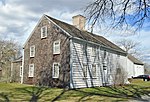Little Compton is a coastal town in Newport County, Rhode Island, bounded on the south by the Atlantic Ocean, on the west by the Sakonnet River, on the north by the town of Tiverton, and on the east by the town of Westport, Massachusetts. The population was 3,589 as of 2022 Town Records.
Little Compton was originally inhabited by the Sakonnet Indians and their settlement was called Sakonnet or Saughonet. The name has been interpreted in a variety of ways including "where the water pours forth".
The first European settlers were from Duxbury, Massachusetts in the Plymouth Colony, which granted them their charter. The ruler of the Native Americans was a female sachem named Awashonks who was friendly to the newcomers and remained so during and after King Phillip's War. With her acquiescence, the new settlers divided the land into standard-sized lots for farms. Among the 29 original proprietors was Colonel Benjamin Church, who would become well known for his role in the late 17th-century conflicts with surrounding Indian tribes, initially the Wampanoags and later, the Narragansetts. In 1675, Church built a house in Little Compton, just prior to King Philip's War. Today, a plaque marks the location on West Main Road.
In 1682, Sakonnet was incorporated by the Plymouth Colony and was renamed Little Compton, presumably in reference to Little Compton in Warwickshire, England. After the "Old Colony" was merged into the Massachusetts Bay Colony to the north, a local colonial representative to the General Court in Boston boasted that all the stone walls in Little Compton would stretch to the State House and back, if laid end to end. A Royal commission changed the state border in 1747, and Little Compton along with Tiverton and Bristol became part of Rhode Island, setting them off from the area of Old Dartmouth. All probate and land records prior to 1746 are kept in Taunton and New Bedford, Massachusetts. Beginning in the late Victorian era, the town became a destination for summer visitors drawn to its beaches and farms seemingly untouched by modernity, and for its relatively cool, maritime climate.









